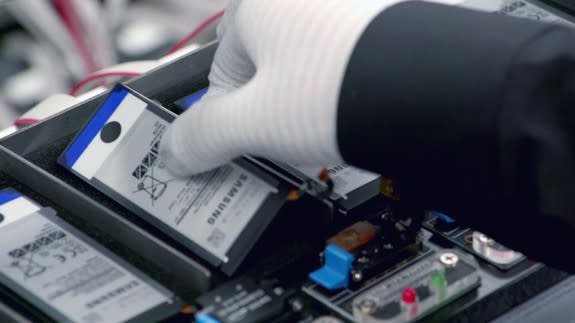Samsung finally put the Note7 scandal to rest—here's what it could do for their future

We may never know why Samsung’s battery manufacturing partners made a handful of critical errors that led dozens of (the once widely-praised) Galaxy Note7 smartphones to overheat, and/or burst into flames.
We also won’t know exactly why most of the 3 million Note7’s that were sold didn’t blow up or catch fire while dozens of others did. The flaws were there, but they obviously needed some other X-factor to trigger the fault.
Think of it this way: If you build two walls, and one's at full thickness and the other's paper-thin, both create a physical barrier you can’t see through. However, if you lean on the paper wall, you’re gonna break through.
Those faulty Note7’s may have encountered another factor like pressure, external heat or drop that wouldn’t have effected properly-manufactured batteries, but were exactly what the faulty ones needed to go up in flames. Samsung’s report doesn’t offer details on specific incidences.
SEE ALSO: Finally, Samsung reveals why the Note 7 exploded
Samsung’s explanation, which it delivered during an hours-long press conference on Sunday night, was exhaustive, illuminating, and a tad too technical. They pinpointed a pair of main causes: a deflected negative electrode and a weld that penetrated insulators, separators, and insulation tape. Contributing factors included a little additional sloppiness: missing insulation tape.
These failures occurred across two separate battery manufacturing runs that, it seems, impacted the first run of phones and the ramp of manufacturing after Samsung thought it had caught and addressed the issue with a small recall.
Since Samsung chose last fall to halt production of the Note7, the device has turned into a cultural touchstone, an easy joke about things that blow up. Even Former President Barack Obama joked about it.
While it’s unclear how much the loss of Note7 sales and concerns about Samsung handsets in general hurt Samsung Mobile Electronics business, there’s no denying Samsung's newfound perception problem. The best way to combat negative perceptions is with new information (check) and new, exciting products (not yet.)
In addition to releasing its full analysis of the Note7 failure, Samsung revealed late Sunday that it won’t be unveiling its next flagship phone, the eagerly anticipated Samsung Galaxy S8 at Mobile World Congress in Barcelona, Spain. While no one expected that product to start shipping before the spring, the fact that the market won’t even get a glimpse of it at the biggest mobile show of the year has to be worrisome for the company. Android users have long chosen Samsung mobile handsets above all others, but Samsung has traditionally fed the beast by delivering one new handset after another. At this writing, Samsung's newest handsets are its collection of Galaxy A devices—mid-range handsets designed primarily for developing markets.
For those who bought the Note7 or the Galaxy S7 (or 6+ Edge), there may not be a new option for six months or more.
Not everyone agrees that Samsung needs a S8 in the near-term. Moor Insights & Strategy President and Principal Analyst Patrick Moorhead believes Samsung did what it needs to do to build trust, and isn't particularly concerned about the lack of a new S8 at Barcelona.
Rushing the S8 to market could potentially hurt Samsung more than it helps it.
The reality is that Android remains, by far, the most popular mobile platform on earth and Samsung is still the leading provider. According to Statistica, global sales of Android handsets topped 300 million as of Q3 2016. Samsung has traditionally accounted for almost of third of those sales. However, Samsung’s mobile earnings have not been that strong as of late. Third quarter earnings, released in late October, 2016, declined sharply.
As of late 2016, according to IDC. Samsung enjoyed a 21% smartphone market share (down from a high of 23.7% in early 2016).
Since the Note7 recall carried over into Q4, it’s still too early to know what kind of impact it had on Samsung smartphone sales.
IDC’s Scarsella, who gives Samsung credit for detailing the Note7 battery issue “in great clarity,” thinks Samsung’s announcement that a Note8 is coming indicates continuing confidence in the Note brand.
Scarsella added that those who favor the Note brand (a relatively niche product in the Galaxy universe) will return to the brand when the Note8 arrives.
Did Samsung lose some Note7 users to Apple and the iPhone 7 Plus? Probably.
Going forward, Samsung will implement one of the most intensive battery production quality assurance program we’ve ever seen. It has eight distinct steps, including visual inspection, accelerated usage tests, and running the batteries through X-Rays to identify any flaws that could turn into disasters.
It’s the kind of move that could have influence beyond Samsung’s battery productions partners, and push competitors like Apple and Google to do the same. Considering our continuing desire for thinner, big-screen handsets with even greater battery life, this could be good news for all manufacturers and consumers.
Barring a Galaxy S8 or Note8 busting into flames in 2017, Samsung should survive this, and get back to the business of competing with Apple and a myriad of other Android handset manufactures.

 Yahoo News
Yahoo News 